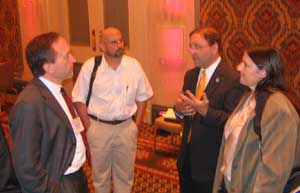You are here: Home › Stressors › Hypoxia & Nutrient Pollution › Current Programs › Hypoxia in the Northern Gulf of Mexico Science Symposium Develops Recommendations for Management Strategies for Mitigating the Gulf of Mexico Hypoxic Zone
CSCOR Co-Sponsors Symposium To Identify Management Strategies for the Gulf of Mexico Hypoxic "Dead Zone"

On April 25-27, 2006, the Hypoxia in the Northern Gulf of Mexico: Assessing the State of the Science Symposium took place in New Orleans, Louisiana. Co-sponsored by the National Centers for Coastal Ocean Sciences’ Center for Sponsored Coastal Ocean Research (CSCOR) and the U.S. Environmental Protection Agency (EPA), the Symposium’s goal was to assess the current scientific understanding of the causes and processes regulating the development, persistence and areal extent of the Gulf’s hypoxic zone (also known as the “Dead Zone”). Fifty-one invited scientists formed panels to evaluate the state-of-the-science on the hypoxia issue and, together with extensive audience question and answer periods, led to comprehensive coverage of Gulf hypoxia science. Plenary presentations were followed by panel and audience discussions of the following topics:
- Characterization and Long-Term Trends of Hypoxia
- Characterization of Nutrient and Organic Matter Loads
- Influence of Physical Oceanographic Processes on the Distribution and Extent of Hypoxia
- Influence of Water Column Processes on Oxygen Dynamics, including Chemical and Biological Transformations Leading to Hypoxia
- Benthic Processes Influencing Oxygen and Nutrient Dynamics
- Modeling Applications, Limitations and Uncertainties
Organization of the Symposium came largely through the cooperative efforts of NOAA and EPA. This strong partnership was evidenced by a keynote session featuring Diane Regas (Acting Assistant Administrator, EPA Office of Water) and Jack Dunnigan (Assistant Administrator, NOAA National Ocean Service). Jack Dunnigan described how the ongoing strategy for managing Gulf hypoxia aligns perfectly with NOAA’s Ecosystem Approach to Management. He emphasized that collaborative and adaptive elements of ecosystem management were on display at the Symposium, which took place as a result of the adaptive management mandate of the multi-agency Mississippi River/Gulf of Mexico Watershed Nutrient Task Force’s 2001 Action Plan for Reducing, Mitigating and Controlling Hypoxia in the Northern Gulf of Mexico.

The Symposium is one of several critical elements of the scientific reassessment processto evaluate and revise the recommendations of the Action Plan. The information from the Symposium will be provided to an EPA Science Advisory Board in the form of state-of-knowledge manuscripts and presentations, panel and outside peer reviews, and transcripts of Symposium panel and audience discussion sessions. The manuscripts will also be submitted to Estuaries and Coasts for collective publication. This comprehensive reassessment will be instrumental in guiding the Task Force on its recommendations for management strategies for mitigating the Gulf of Mexico hypoxic zone. For additional details, please see CSCOR's Hypoxia page.
For More Information, Please Contact:
Alan Lewitus
NOAA/NOS/NCCOS/Center for Sponsored Coastal Ocean Research
Phone: 301-713-3338 x 178
E-mail: Alan.Lewitus@noaa.gov

